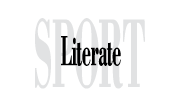The List
https://sportliterate.org/wp-content/themes/osmosis/images/empty/thumbnail.jpg 150 150 bjj-sportliterate bjj-sportliterate https://secure.gravatar.com/avatar/592f60292ffae558017e7047d039bebe88be7eca3a999965f3a7f0501ad82d49?s=96&d=mm&r=gThe List
by Todd Morgan
Sam and I were having lunch at the kitchen table. His baseball cap shielded his eyes as he leaned over a piece of paper, pencil grasped in his small hand, his PB&J partly eaten.
“What’s that?” I said.
He didn’t look up.
“Coach said if he was going to war, he’d take some of the guys with him, but some of us he wouldn’t.”
I put down my newspaper and peered across the table. I saw a partial listing of his teammates’ names: Matt, Ricky, …. My nine-year-old was trying to figure out which group he fell in. Go to war or be left at home?
I felt a sudden urge to shield him.
The young coach who said this, Nick, had a swagger about him, one that was either contagious or obnoxious depending on whether you were associated with his team or the opposition. A star high school athlete just a few years earlier, he wore mirrored sunglasses and shaved his head. The kids idolized him.
Like most coaches, Nick had a deep competitive streak. But unlike most coaches, he seemed to know how to fully embrace competition while keeping things in perspective. Time after time he steeled the team to rally from a deficit. He would build up the confidence of each batter, one pitch at a time. For a boy intent on driving in a run, he’d call out, “Just make contact.” To boost a kid battling deep in the count, he’d yell, “Good at bat.” If a pitcher challenged a baserunner’s lead, well then, on the next pitch Nick would shout to the boy to take an even bigger lead. It was a master class in pitting one’s will against the opponent.
Then, once the game ended and he had talked to the team about lessons learned, his intensity vanished. Lighthearted and matter-of-fact behind the mirrored shades, he would crank up the volume on his car stereo and head off into the afternoon blasting “We Like to Party! (The Vengabus).”
Why was this good coach challenging these young boys with a misguided war analogy? Might one of them quietly conclude at nine or ten years old that he was a coward? Was I over reacting?
Sam loved sports, and I wanted to help him be successful. We enjoyed tossing the ball back and forth. I bought him an expensive aluminum bat. Sometimes I pitched to him, or we went to the batting cages and then got hot dogs afterward. Occasionally I cleaned caked mud off his cleats at night after he was asleep and wondered if I was too invested. But there were plenty of other parents like my wife and me, who went to every game and followed each pitch.
When I was Sam’s age, my brother Greg enlisted in an intelligence branch of the army. The enlistment officer told him that because he’d be schooled in top secret codes, he’d never be sent to a combat zone, so he’d never be in jeopardy of revealing secrets if captured and tortured. Greg was pleased and thought he had sidestepped Vietnam. The officer’s story, while plausible and correct in the small details, was a stunning lie.
I often studied the photo that sat on top of the TV while Greg was gone: my parents and him standing next to each other at the airport, my mom with red eyes, my dad wearing a suit and a grim expression, my brother frowning in his dress uniform with its few ribbon medals. Before the army, Greg wore oxford cloth shirts, drank Pepsi, smoked a pipe, read Playboy, and listened to Dave Brubeck. When he came home, he drank beer, smoked pot, worked ‘fuck’ and its variations into almost every conversation, and listened to The Band, Dylan, and Jimi Hendrix.
He told me a story about a highly decorated soldier who did something violent and obscene to a cat. He taught me I could solve life’s problems just by saying “fuck it.” From all of this I understood war was a kind of betrayal or, as Greg would have put it, a complete fucking mess.
There’s a photo I love of Greg taken in Saigon in 1968. It’s a head shot of him in jungle fatigues. He’s wearing a boonie hat and standard issue glasses. The freckles across the bridge of his nose remind me of Sam. His blue eyes stare with childlike determination as he sticks out his tongue at the camera.
I had never considered Sam going to war until Nick’s comment triggered me like an unexpected muscle memory. I doubt I could’ve tempered my response to Sam if I’d known that ultimately Greg would die of ALS. It’s a brutal disease that progressively weakens the muscles, including ones you didn’t know you had. Near the end, Greg couldn’t even close his eyes. The causes of ALS are unknown but veterans are twice as likely to get it as the general population. The US government presumes there’s a service connection when a vet gets the disease.
To try to convey my attitude to a nine-year-old focused on baseball would have been foolish. At the same time, it was insidiously easy to challenge a kid to jump on the war bandwagon and thereby plant seeds of moral confusion about what war is – and isn’t. I also feared one day Sam might have a life-changing conversation with an army recruiter, possibly a charismatic young man with a shaved head and sunglasses.
“Sam…. Nick doesn’t know you well enough to say something like that.”
The baseball cap tipped up and Sam looked out for a moment. It seemed he registered what I said though there was a distant look in his eyes. Then, he returned to pondering the list.
Watching Sam hunkered down, I faced the fact that I would be on guard but he would make his own choices.
I pretended to resume reading my newspaper and we sat together.
Todd Morgan’s stories have appeared in Split Lip Magazine and Every Day Fiction. He was born in Indiana and grew up in Kentucky and New Jersey. He lives with his wife in Oak Park, Illinois.


